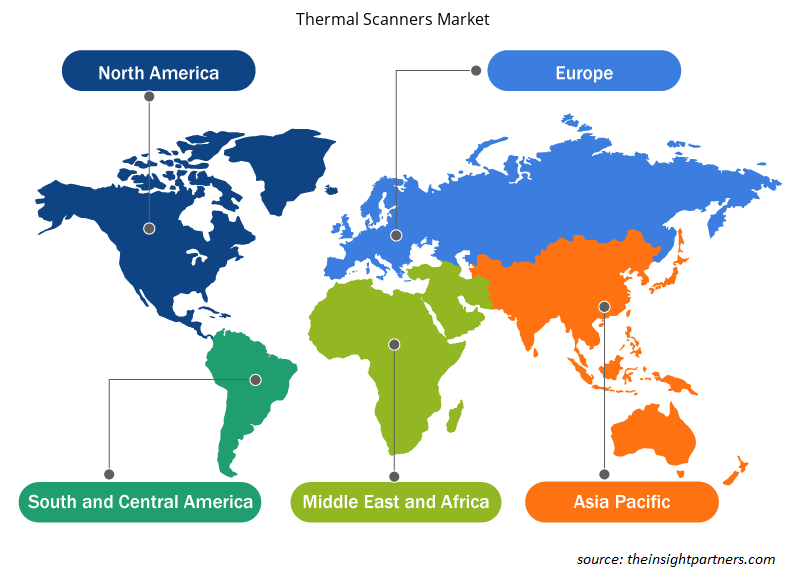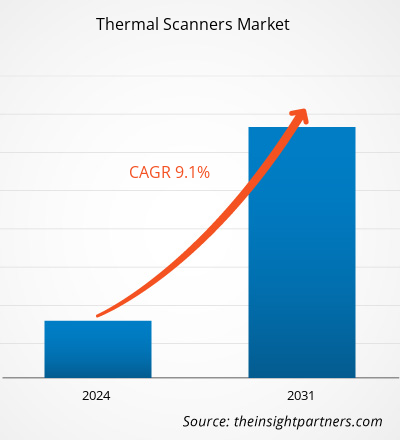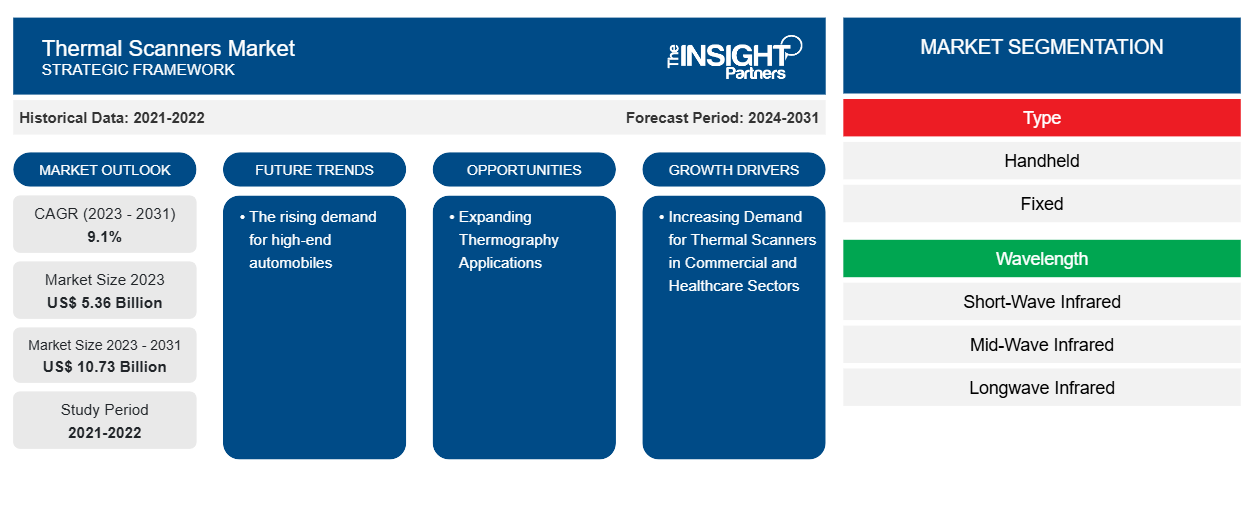Der Markt für Wärmescanner soll von 5,36 Milliarden US-Dollar im Jahr 2023 auf 10,73 Milliarden US-Dollar im Jahr 2031 anwachsen. Der Markt wird voraussichtlich zwischen 2023 und 2031 eine durchschnittliche jährliche Wachstumsrate von 9,1 % verzeichnen. Die steigende Nachfrage nach hochwertigen Automobilen dürfte ein wichtiger Markttrend für Wärmescanner bleiben.
Marktanalyse für Wärmebildkameras
Der Markt für Wärmescanner wächst rasant, da die Nachfrage nach Wärmescannern im kommerziellen und Gesundheitswesen steigt und die Investitionen in Forschung und Entwicklung zur Entwicklung innovativer Wärmescanner steigen. Der Markt wächst stetig, angetrieben durch die zunehmende Installation an verschiedenen öffentlichen Orten, darunter Flughäfen, Krankenhäuser und andere zu Erkennungszwecken. Darüber hinaus bieten wachsende Thermografieanwendungen , technologische Fortschritte und die Integration von künstlicher Intelligenz und Gesichtserkennungstechnologien lukrative Möglichkeiten für Marktwachstum.
Marktübersicht für Wärmescanner
Infrarot-Wärmescanner sind nicht-invasive Bildgebungsinstrumente, die die von jedem Objekt erzeugte Wärme erfassen und in elektrische Signale umwandeln. Ihre Anwendungsmöglichkeiten haben im Laufe der Zeit in einer Vielzahl von Bereichen zugenommen, darunter Industriebetriebe, therapeutische Behandlungszentren, Forschungslabore und Polizeibehörden. Die Diversifizierung und das Wachstum vieler Anwendungen haben in den letzten Jahren den Umsatz mit Wärmescannern in mehreren Volkswirtschaften gesteigert.
Passen Sie diesen Bericht Ihren Anforderungen an
Sie erhalten kostenlose Anpassungen an jedem Bericht, einschließlich Teilen dieses Berichts oder einer Analyse auf Länderebene, eines Excel-Datenpakets sowie tolle Angebote und Rabatte für Start-ups und Universitäten.
-
Holen Sie sich die wichtigsten Markttrends aus diesem Bericht.Dieses KOSTENLOSE Beispiel umfasst eine Datenanalyse von Markttrends bis hin zu Schätzungen und Prognosen.
Markttreiber und Chancen für Wärmescanner
Die steigende Nachfrage nach Wärmescannern im gewerblichen und medizinischen Bereich treibt den Markt an
Wärmebildkameras sind im kommerziellen und im Gesundheitssektor für Sicherheits- und Überwachungsanwendungen sehr gefragt. Der wachsende Bedarf an Sicherheits- und Überwachungsanwendungen in Verbindung mit dem hohen Sicherheitsbedürfnis von Mitarbeitern und Bewohnern treibt den Markt an. Wärmebildkameras bieten den Benutzern aufgrund ihrer geringen Kosten im Vergleich zu CCTV- Systemen einen hohen Return on Investment ( ROI ) . Die Gesamtinstallationskosten eines auf Wärmebildkameras basierenden Sicherheitssystems sind weitaus niedriger als die eines CCTV-Systems, was seine Akzeptanz im kommerziellen und im Gesundheitssektor erhöht. Es wird jedoch erwartet, dass die zunehmenden Investitionen in Infrastruktursysteme im kommerziellen und im Gesundheitssektor in Verbindung mit dem Bedarf an professioneller Überwachung den Markt antreiben werden.
Erweiterte Thermografieanwendungen – eine Chance auf dem Markt für Wärmescanner
Thermografie wird in der Medizinbranche häufig zur Überwachung des Blutdrucks, bei Herzoperationen, zur Diagnose von Lebererkrankungen und zur Erkennung von Brustkrebs eingesetzt. Die Thermografieanwendung verwendet eine Infrarotkamera in einem Wärmescanner, um Blutfluss und Wärmemuster in Körpergeweben zu erkennen. Darüber hinaus bieten steigende Ausgaben der Medizinbranche und zunehmende Forschungs- und Entwicklungsaktivitäten zur Entwicklung fortschrittlicher Wärmescanner im Prognosezeitraum erhebliche Wachstumschancen für den Markt.
Segmentierungsanalyse des Marktberichts für Wärmescanner
Wichtige Segmente, die zur Ableitung der Marktanalyse für Wärmescanner beigetragen haben, sind Typ, Wellenlänge und Endverwendung.
- Basierend auf dem Typ ist der Markt für Wärmescanner in tragbare und stationäre Geräte unterteilt. Das stationäre Segment hatte im Jahr 2023 einen größeren Marktanteil.
- Auf der Grundlage der Wellenlänge ist der Markt für Wärmescanner in kurzwelliges Infrarot, mittelwelliges Infrarot und langwelliges Infrarot unterteilt. Das Segment langwelliges Infrarot hatte im Jahr 2023 einen größeren Marktanteil.longwave infrared. The longwave infrared segment held a larger market share in 2023.
- In Bezug auf die Endnutzung wird der Markt in die Bereiche Industrie, Luft- und Raumfahrt und Verteidigung, Automobil, Öl und Gas und Sonstige unterteilt. Das Segment Luft- und Raumfahrt und Verteidigung hatte im Jahr 2023 einen größeren Marktanteil.
Marktanteilsanalyse für Wärmescanner nach geografischer Lage
Der geografische Umfang des Marktberichts für Wärmescanner ist hauptsächlich in fünf Regionen unterteilt: Nordamerika, Asien-Pazifik, Europa, Naher Osten und Afrika sowie Südamerika/Süd- und Mittelamerika. In Bezug auf den Umsatz hatte Nordamerika aufgrund der wachsenden Luft- und Raumfahrt- und Verteidigungsindustrie den größten Marktanteil bei Wärmescannern.
Der Markt im asiatisch-pazifischen Raum dürfte in naher Zukunft wachsen, da viele Anbieter kostengünstige Lösungen anbieten, was die Nachfrage nach Wärmescannern bei den Endverbrauchern erhöht. Steigende Investitionen und die Expansion zahlreicher Branchen, darunter Industrie, Luft- und Raumfahrt und Verteidigung, Automobil, Öl und Gas und andere, schaffen Chancen auf dem Markt. Diese Branchen setzen Wärmescanner in großem Umfang für Überwachungszwecke ein, was eine Massenproduktion anregt. Dies wird den Markt im Prognosezeitraum ankurbeln.
Regionale Einblicke in den Markt für Wärmescanner
Die regionalen Trends und Faktoren, die den Markt für Thermoscanner im Prognosezeitraum beeinflussen, wurden von den Analysten von Insight Partners ausführlich erläutert. In diesem Abschnitt werden auch die Marktsegmente und die Geografie für Thermoscanner in Nordamerika, Europa, im asiatisch-pazifischen Raum, im Nahen Osten und Afrika sowie in Süd- und Mittelamerika erörtert.

- Holen Sie sich die regionalspezifischen Daten für den Markt für Wärmescanner
Umfang des Marktberichts zu Wärmescannern
| Berichtsattribut | Details |
|---|---|
| Marktgröße im Jahr 2023 | 5,36 Milliarden US-Dollar |
| Marktgröße bis 2031 | 10,73 Milliarden US-Dollar |
| Globale CAGR (2023 - 2031) | 9,1 % |
| Historische Daten | 2021-2022 |
| Prognosezeitraum | 2024–2031 |
| Abgedeckte Segmente |
Nach Typ
|
| Abgedeckte Regionen und Länder |
Nordamerika
|
| Marktführer und wichtige Unternehmensprofile |
|
Marktdichte von Wärmebildkameras: Auswirkungen auf die Geschäftsdynamik verstehen
Der Markt für Wärmescanner wächst rasant, angetrieben durch die steigende Nachfrage der Endnutzer aufgrund von Faktoren wie sich entwickelnden Verbraucherpräferenzen, technologischen Fortschritten und einem größeren Bewusstsein für die Vorteile des Produkts. Mit steigender Nachfrage erweitern Unternehmen ihr Angebot, entwickeln Innovationen, um die Bedürfnisse der Verbraucher zu erfüllen, und nutzen neue Trends, was das Marktwachstum weiter ankurbelt.
Die Marktteilnehmerdichte bezieht sich auf die Verteilung von Firmen oder Unternehmen, die in einem bestimmten Markt oder einer bestimmten Branche tätig sind. Sie gibt an, wie viele Wettbewerber (Marktteilnehmer) in einem bestimmten Marktraum im Verhältnis zu seiner Größe oder seinem gesamten Marktwert präsent sind.
Die wichtigsten auf dem Markt für Wärmescanner tätigen Unternehmen sind:
- FLIR Systems, Inc.
- AMETEK Inc.
- Robert Bosch GmbH
- 3M
- Leonardo
- Elektrooptische Industrie
Haftungsausschluss : Die oben aufgeführten Unternehmen sind nicht in einer bestimmten Reihenfolge aufgeführt.

- Überblick über die wichtigsten Akteure auf dem Markt für Wärmescanner
Neuigkeiten und aktuelle Entwicklungen zum Markt für Wärmescanner
Der Markt für Wärmescanner wird durch die Erhebung qualitativer und quantitativer Daten nach Primär- und Sekundärforschung bewertet, die wichtige Unternehmensveröffentlichungen, Verbandsdaten und Datenbanken umfasst. Im Folgenden finden Sie eine Liste der Entwicklungen auf dem Markt für Wärmescanner und Strategien:
- Im Januar 2024 werden Valeo und Teledyne FLIR die erste Wärmebildtechnologie mit Automotive Safety Integrity Level (ASIL) B für Nachtsicht-ADAS liefern. Dieses System wird Valeos große Sensorpalette ergänzen und auf Valeos ADAS-Software-Stack basieren, um Funktionen wie die automatische Notbremsung (AEB) bei Nacht für Personen- und Nutzfahrzeuge sowie für autonome Autos zu unterstützen. (Quelle: Valeo, Pressemitteilung, 2024)
Marktbericht zu Wärmebildscannern – Umfang und Ergebnisse
Der Bericht „Marktgröße und Prognose für Wärmebildkameras (2021–2031)“ bietet eine detaillierte Analyse des Marktes, die die folgenden Bereiche abdeckt:
- Marktgröße und Prognose auf globaler, regionaler und Länderebene für alle wichtigen Marktsegmente, die im Rahmen des Projekts abgedeckt sind
- Marktdynamik wie Treiber, Beschränkungen und wichtige Chancen
- Wichtige Zukunftstrends
- Detaillierte PEST/Porters Five Forces- und SWOT-Analyse
- Globale und regionale Marktanalyse mit wichtigen Markttrends, wichtigen Akteuren, Vorschriften und aktuellen Marktentwicklungen
- Branchenlandschaft und Wettbewerbsanalyse, einschließlich Marktkonzentration, Heatmap-Analyse, prominenten Akteuren und aktuellen Entwicklungen
- Detaillierte Firmenprofile
- Historische Analyse (2 Jahre), Basisjahr, Prognose (7 Jahre) mit CAGR
- PEST- und SWOT-Analyse
- Marktgröße Wert/Volumen – Global, Regional, Land
- Branchen- und Wettbewerbslandschaft
- Excel-Datensatz
Aktuelle Berichte
Erfahrungsberichte
Grund zum Kauf
- Fundierte Entscheidungsfindung
- Marktdynamik verstehen
- Wettbewerbsanalyse
- Kundeneinblicke
- Marktprognosen
- Risikominimierung
- Strategische Planung
- Investitionsbegründung
- Identifizierung neuer Märkte
- Verbesserung von Marketingstrategien
- Steigerung der Betriebseffizienz
- Anpassung an regulatorische Trends























 Kostenlose Probe anfordern für - Markt für Wärmescanner
Kostenlose Probe anfordern für - Markt für Wärmescanner